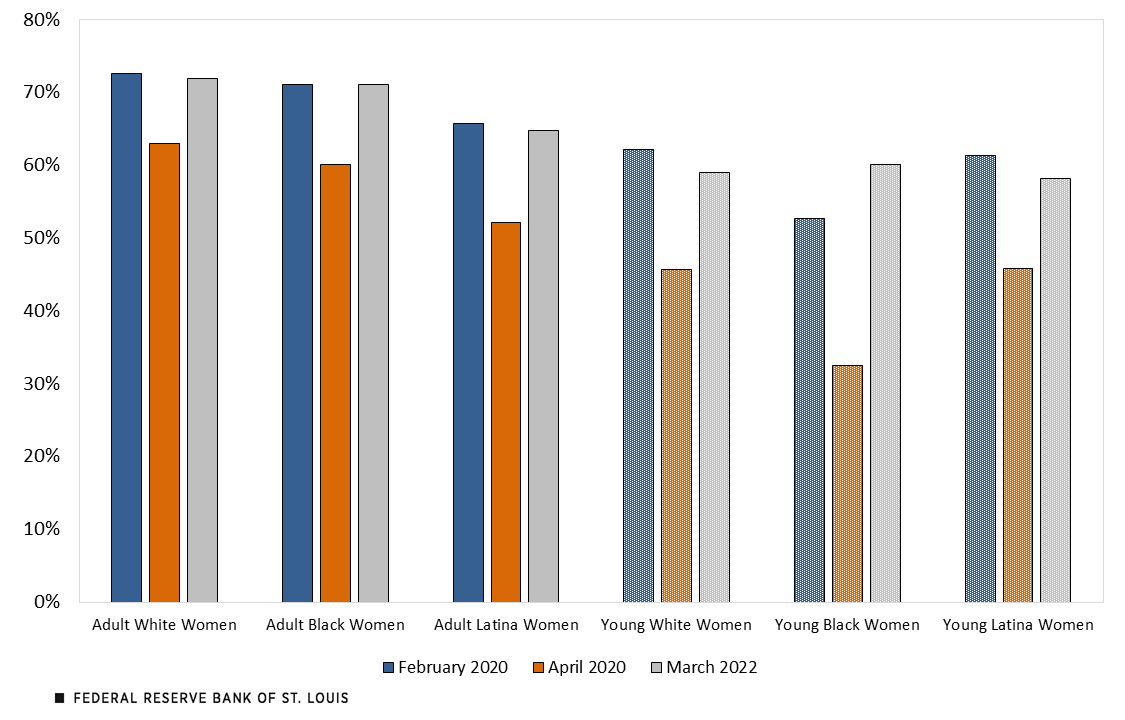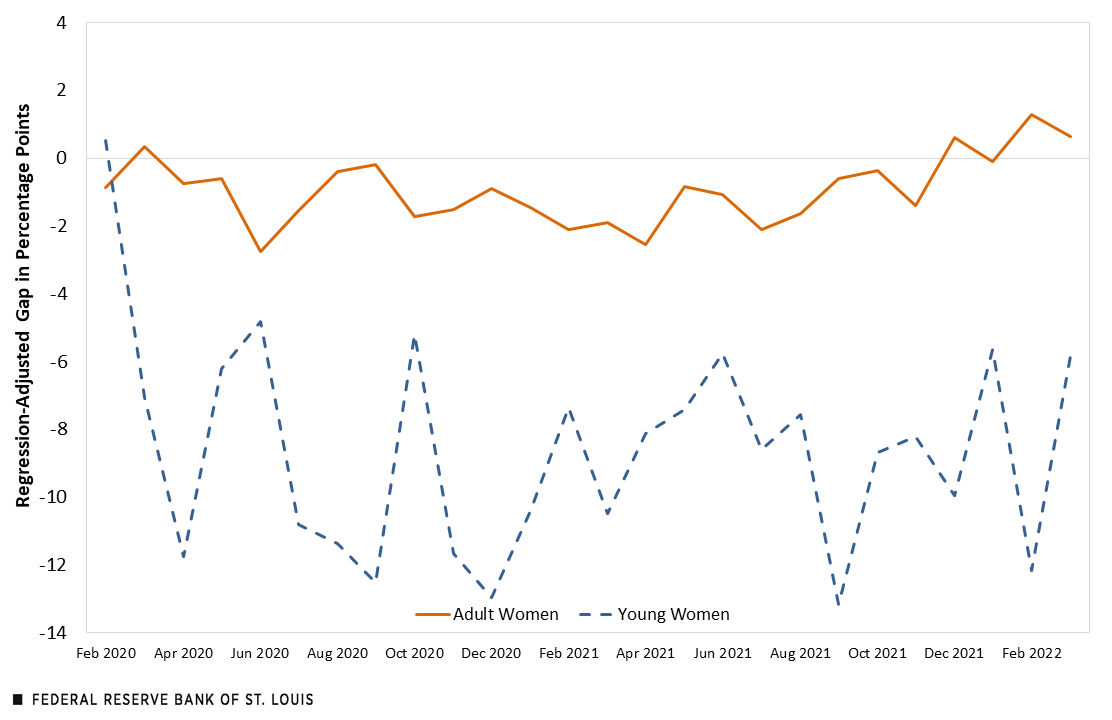Young Adults without College Education See Uneven Jobs Recovery
Relief and recovery investments during the pandemic have made this most recent job recovery unique relative to others in past decades. In fact, major efforts to restore the economy’s health and commitments to lessen racial inequality, combined with widespread labor shortages, have helped to create a “moment of opportunity” for young noncollege-educated adults. These young adults are 16- to 24-year-olds who are not enrolled in school, have no more than a high school degree and have no more than 10 years of potential labor market experience. Potential labor market experience equals age minus years of schooling minus 6. This moment is especially crucial for young noncollege-educated adults because early career opportunities are key for their long-term earnings prospects. They tend to have fewer skills and credentials and weaker job search networks, and face geographic isolation from job opportunities, making a potential toehold in the labor market all the more important to securing their economic futures. Young Black and Latino adults also face additional hurdles, such as discrimination.
The challenges are even greater for the current cohort of noncollege-educated youth who have entered the labor force during the pandemic. Research has shown that in the aftermath of a recession, youth who enter labor markets experience lower income over their lives. The COVID-19 pandemic is the latest example of a public health and economic shock that could adversely impact their futures. This blog post, the first in a two-part series, assesses how well young noncollege-educated adults, especially young Black adults and young Latino adults, are faring during the recovery. This series is published as part of the vulnerable workers initiative from the Institute for Economic Equity. The initiative examines the challenges facing vulnerable workers during the recovery and discusses potential ways to improve their economic security and resiliency in an economy reshaped by the pandemic. Simply put, their recovery is one of unevenness.
Noncollege-Educated Youth Experienced an Uneven Recovery
During the nation’s job recovery (April 2020 to April 2022), the overall civilian unemployment rate fell from 14.7% to 3.6%. Payroll employment returned almost to its pre-pandemic level. The employment-to-population ratios of some noncollege-educated men and women have returned to or exceeded their pre-pandemic levels; however, this literally happened since December 2021.* For example, as the following figure shows, the employment-to-population ratio of young Black men reached 62.1%, exceeding its pre-pandemic value of 56.3% and its December 2021* level of 56.1%. These estimates are through March 2022 because the micro data from which these estimates are calculated are only publicly available through March 2022 and not April 2022. In recent months, the ratio for young Latino men recovered to its pre-pandemic level.
Employment-to-Population Ratios for Men

SOURCES: Current Population Survey and author’s calculations.
NOTES: Adults are 25 to 64 years old, with no restrictions on educational attainment. Young adults are 16 to 24 years old with no more than a high school degree, not enrolled in school and have no more than 10 years of potential work experience (age minus years of schooling minus 6).
The next figure reports that the employment-to-population ratio of young Black women recovered to 60.0%, 7.4 percentage points above its pre-pandemic value of 52.6%. The ratios of both young white men and young white women were 2.1 percentage points and 3.2 percentage points, respectively, below their pre-pandemic values.
Employment-to-Population Ratios for Women

SOURCES: Current Population Survey and author’s calculations.
NOTES: Adults are 25 to 64 years old, with no restrictions on educational attainment. Young adults are 16 to 24 years old with no more than a high school degree, not enrolled in school and have no more than 10 years of potential work experience (age minus years of schooling minus 6).
Large Racial and Ethnic Employment Gaps Remain after 24 Months of Recovery
The average employment gap—the difference between their employment-to-population ratios—between young Black men and young white men since January 2020 to March 2022 is 15.0 percentage points. Over the same period, the average employment gap between adult Black men and adult white men was 10.9 percentage points, and it was 8.6 percentage points between young Black women and young white women. The only group near parity with its white counterpart is adult Black women.
These gaps are surprising because of the relative gains we would expect young Black and Latino adults to experience as a result of relief and recovery efforts (e.g., the American Rescue Plan and CARES acts) during the pandemic that were particularly impactful for families with the greatest need as well as the “Great Resignation” and its contribution to labor shortages. Furthermore, this most recent recovery is inconsistent with the historical link between overall economic conditions and outcomes for young noncollege-educated adults. In the past, strong economic recoveries have had a disproportionate positive impact on employment among young, noncollege-educated Black men.
Unfortunately, as of March 2022, these conditions did not lead to a narrowing in racial and ethnic employment gaps, and Black and Latino people have experienced persistent disadvantages. The figure below shows that, throughout the jobs recovery following the COVID-19 recession, the employment gap between young Black men and young white men stayed between about 8.2 percentage points and 21.0 percentage points. The gap between adult Black men and adult white men ranged from 8.1 percentage points to 13.1 percentage points.
Differences in Employment-to-Population Ratios between Black and White Men

Differences in Employment-to-Population Ratios between Latino and White Men

SOURCES FOR BOTH FIGURES: Current Population Survey and author’s calculations.
NOTES FOR BOTH FIGURES: The negative gaps mean that the percentages of Black men and Latino men who are employed are smaller than the share for white men. Adults are 25 to 64 years old, with no restrictions on educational attainment. Youths are 16 to 24 years old with no more than a high school degree, not enrolled in school and have no more than 10 years of potential work experience. Estimates come from linear probability models in which an indicator of employment is regressed on educational attainment and potential experience and dummy variables for race, ethnicity, month and state.
The figure below reports that young Black women also experienced a persistent disadvantage relative to their white peers, while adult Black women are close to parity with adult white women. And the sixth figure shows that both young Latina women and adult Latina women faced persistently lower employment than white women. Still, there may be some evidence that young Latina women have narrowed the gap by March 2022. Since the pandemic, adult Latina women have employment-to-population ratios that are 4.7 percentage points to 11.2 percentage points below adult white women.
Differences in Employment-to-Population Ratios between Black and White Women

Differences in Employment-to-Population Ratios between Latina and White Women

SOURCES FOR BOTH FIGURES: Current Population Survey and author’s calculations.
NOTES FOR BOTH FIGURES: The negative gap means the percentages of Black women and Latina women who are employed are smaller than the percentage for white women. Adults are 25 to 64 years old, with no restrictions on educational attainment. Youths are 16 to 24 years old with no more than a high school degree, not enrolled in school and have no more than 10 years of potential work experience. Estimates come from linear probability models in which an indicator of employment is regressed on dummy variables for race and ethnicity, month dummy variables, educational attainment, potential experience and state dummy variables.
This evidence suggests that noncollege-educated youth are not fully benefiting from this moment of opportunity. Even with one of the tightest labor markets since World War II, large-scale relief and recovery responses, societal pledges to reduce racial inequality and the exit of adult workers from the labor force, young, noncollege-educated Black Americans and Latino Americans have yet to experience a relative improvement in their economic standing, at least as measured by employment.
The second part of this blog series will explore how strong the macroeconomy must be to improve not only the absolute but also the relative economic status of noncollege-educated youth. The post will also discuss ways to narrow the employment gap.
*Editor's Note: This article was updated to correct the year.
Notes and References
1 These young adults are 16- to 24-year-olds who are not enrolled in school, have no more than a high school degree and have no more than 10 years of potential labor market experience. Potential labor market experience equals age minus years of schooling minus 6.
2 This series is published as part of the vulnerable workers initiative from the Institute for Economic Equity. The initiative examines the challenges facing vulnerable workers during the recovery and discusses potential ways to improve their economic security and resiliency in an economy reshaped by the pandemic.
3 These estimates are through March 2022 because the micro data from which these estimates are calculated are only publicly available through March 2022 and not April 2022.
Citation
William M. Rodgers III, ldquoYoung Adults without College Education See Uneven Jobs Recovery,rdquo St. Louis Fed On the Economy, May 17, 2022.
This blog offers commentary, analysis and data from our economists and experts. Views expressed are not necessarily those of the St. Louis Fed or Federal Reserve System.
Email Us
All other blog-related questions


